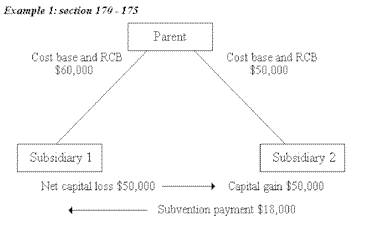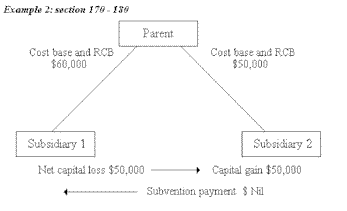Draft Taxation Determination
TD 1999/D33
Income tax: capital gains: if a company transfers a net capital loss under Subdivision 170-B of the Income Tax Assessment Act 1997 ('the 1997 Act'):
- (a)
- when do the adjustments required by section 170-175 or 170-180 to the cost base and reduced cost base ('RCB') of a group company's interests in the loss company or the gain company take effect; and
- (b)
- what happens if a subvention payment (loss company) or a tax benefit (gain company) that would otherwise be taken into account in determining the amount of any adjustment, is no longer reflected in the market value of an interest at the time a CGT event happens to it because the subvention payment or tax benefit has been distributed as a dividend?
-
Please note that the PDF version is the authorised version of this draft ruling.This document has been finalised by TD 2001/17.
FOI status:
Preamble
| Draft Taxation Determinations (DTDs) present the preliminary, though considered, views of the Australian Taxation Office. DTDs should not be relied on; only final Taxation Determinations represent authoritative statements by the Australian Taxation Office. |
(a) Time adjustments to cost base and RCB take effect
1. Adjustments to the cost base and RCB of a group company's direct and indirect interests in the loss or gain company on the transfer of a net capital loss take effect at the end of the application year (i.e., the income year of the gain company for which the amount is transferred: subsection 170-115(1)).
Note 1: No adjustments are required to group company interests that do not exist at the end of the application year.
Note 2: As to the transfer limitation in subsections 170-145(2) to 170-145(4) for a particular net capital loss transfer, these subsections are applied to the cost bases of the share or debt interests before any adjustments required by section 170-175 in respect of that transfer take effect. Adjustments in respect of earlier transfers are, however, relevant.
(b) Distribution of subvention payment or tax benefit
2. An adjustment made to the cost base and RCB may have regard to an amount representing:
- (a)
- a subvention payment in relation to an interest in the loss company (section 170-175); or
- (b)
- a tax benefit arising from the transferred loss in relation to an interest in the gain company (section 170-180);
except (as set out in paragraph 3) to the extent that the amount is distributed as a dividend for tax purposes and is no longer reflected in the market value of the interest at the time a CGT event happens to it.
- (a)
- a CGT event happens to an interest;
- (b)
- a subvention payment or a tax benefit would otherwise be taken into account in determining the amount of an adjustment required by section 170-175 or 170-180; and
- (c)
- all or part of the increase in the value of the interest attributable to the subvention payment or tax benefit is not reflected at the time of the CGT event because the subvention payment or tax benefit has been distributed (in whole or in part) as a dividend;
the distributed amount is not taken into account in making the adjustment.
4. We accept that an amount referable to all or part of a subvention payment or tax benefit has not been distributed as a dividend, provided the company can do either of the following:
- •
- demonstrate that the subvention payment or tax benefit (or part thereof) has not been distributed as a dividend for tax purposes; or
- •
- point to an amount of undistributed profit in its accounts equal to the whole or part of the subvention payment or tax benefit. If more than one subvention payment has been made (or tax benefit has arisen) then an assertion that more than one amount has not been distributed requires identification of the sum of the relevant amounts. In either case, however, strict tracing of a subvention payment or tax benefit to a particular undistributed amount is not required.
Note 3: For accounting purposes the receipt of a subvention payment is treated as a credit to the income tax expense account and, therefore, effectively an increase to profit and loss after income tax (see AARF Accounting Guidance Release 4, issued 12/85)). Many factors bear on whether a subvention payment can actually be paid as a dividend (e.g., whether it represents a distributable profit for Corporations Law purposes).
5. Taxpayers may apply the approach set out in this Taxation Determination to adjustments under section 160ZP of the Income Tax Assessment Act 1936 ('the 1936 Act') subject to the statutory limits of section 170 of the 1936 Act.
6. This draft Determination, when finalised, will replace Taxation Determination TD 94/90, which will then be withdrawn. The draft Determination is more favourable than TD 94/90 and will have both a past and future application (subject again to the statutory limits of section 170 of the 1936 Act).
Note 4: The term 'subvention payment' in this Taxation Determination refers to a sum paid by a transferee company to a transferor company as consideration for a transfer of a loss. The term 'tax benefit' in this Taxation Determination refers to the increase in the market value of the gain company that results from the amount of loss transferred. There is no increase if a subvention payment equal to the tax benefit of the loss transferred is made by the gain company.

7. Facts: After 19 September 1985, Parent capitalised Subsidiary 1 with $60,000 and Subsidiary 2 with $50,000. Subsidiary 1 purchased an asset for $60,000, which later declined in value and was sold for $10,000. Subsidiary 1 made a capital loss of $50,000, which became a net capital loss. Later, Subsidiary 2 made a capital gain of $50,000 on the sale of an asset and an agreement was made whereby Subsidiary 1 transferred the net capital loss of $50,000 to Subsidiary 2. A subvention payment of $18,000 was made for the net capital loss transferred.
8. If Parent later sells its shares in Subsidiary 1 for $28,000 and, immediately before that time, Parent can show it has received no dividend from Subsidiary 1 since the end of the application year, or Parent can point to an undistributed profit amount of $18,000 in Subsidiary 1, it would be appropriate to reduce the cost base and RCB of Parent's shares in Subsidiary 1 by $32,000 (from $60,000 to $28,000). The adjustments would take effect at the end of the application year (i.e., the income year of the gain company for which the amount is transferred: subsection 170-115(1)).

9. Assume the same facts as for Example 1, except that Subsidiary 2 makes no subvention payment for the transferred net capital loss. If Parent later sells its shares in Subsidiary 2 and, immediately before that time, Parent can show it has received no dividend from Subsidiary 2 since the end of the application year, or can point to $18,000 undistributed profits in Subsidiary 2, a cost base and RCB increase of $18,000 to its shares in Subsidiary 2 would be appropriate. The increase would take effect at the end of the application year. In respect of the cost base, indexation would be available from that time.
10. If, for example, the entire gain of $50,000 were distributed before Parent sold its shares in Subsidiary 2, and Subsidiary 2 has no other distributable profits immediately before the shares are sold, no increase to the cost base and RCB of the shares would be made.
Note 5: On the facts above, it would also be appropriate in terms of section 170-175 for Parent to reduce its cost base and RCB of its shares in Subsidiary 1 by $50,000 with effect from the end of the application year. The transfer limitation in subsections 170-145(2 )to (4) would be applied to the level of cost base before this adjustment (i.e., the cost base of $60,000 exceeds the transfer amount of $50,000 so there is no restriction imposed by these subsections).
Your comments
11. If you wish to comment on this draft Taxation Determination, please send your comments by Friday 6 August 1999 to:
| Contact officer details have been removed following publication of the final ruling. |
Commissioner of Taxation
7 July 1999
This Draft Determination replaces TD 1999/D31 (withdrawn on 2 July 1999)
References
ATO references:
NO 99/8922-6
BO
Related Rulings/Determinations:
TD 1999/D32
Subject References:
cost base
cost base adjustment
distribution
dividend
FIFO
gain company
loss company
loss transfer
net capital loss
rebatable dividend adjustment
reduced cost base
subvention payment
tax benefit
transfer of loss
Legislative References:
ITAA36 160ZP
ITAA36 160ZP(13)
ITAA36 160ZP(14)
ITAA36 160ZP(15)
ITAA36 170
ITAA97 170-115(1)
ITAA97 170-145(2)
ITAA97 170-145(3)
ITAA97 170-145(4)
ITAA97 170-175
ITAA97 170-180
ITAA97 170-B
